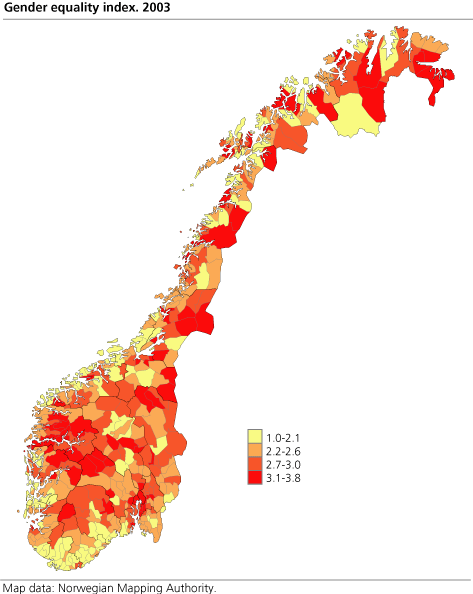Content
Published:
This is an archived release.
Women and men in Oslo most equal
The gender equality index for 2003 reveals considerable regional and local differences. On county level, Oslo has the highest score, followed by Akershus. Vest-Agder has the lowest score. Rollag and Leikanger have the highest score among the municipalities.
The gender equality index has been published by Statistics Norway since 1999. Among the counties, Oslo scores highest with 3.4 points in total, followed by Akershus with 3.0 points. The municipalities of Akershus do particularly well on the indicators numbers of women per 100 men, Percentage of women in labour force and Percentage of female municipal council members. The municipalities of Akershus are all above the national average of 2.5 points.
The counties of Finnmark, Buskerud and Sogn og Fjordane also score high on the index. Finnmark does well on all four indicators and particularly well on kindergarten coverage and income. One of the reasons behind this is that the index, in addition to comparing conditions for women across municipalities, also estimates differences in education levels, labour force participation and income between women and men for each municipality.
Southern counties lag behind
The counties of Vest-Agder and Aust-Agder in the south of Norway are ranked last and third to last, with Møre og Romsdal between them. The three counties have had the lowest scores on the index in the last years. Apart from Aust-Agder's score above the national average on education levels, they have low scores on each indicator. However, several of the municipalities in these counties have scores above the national average.
Small changes in ranking between municipalities
Rollag in Buskerud county and Leikanger in Sogn og Fjordane county have the highest score among the municipalities. At 3.8 points they are closely followed by four municipalities with an index score of 3.7. The four largest municipalities, Oslo, Bergen, Stavanger and Trondheim have scores above the national average.
Farsund in Vest-Agder has the lowest score at 1.1 points.
The gender equality index reveals no major changes from last year. This is partly due to the fact that the number of municipal council members has been identical for the past four years. Next year's index will include figures based on the 2003 municipal council election and is likely to reveal larger changes.
Many ways to depict gender equality
Equality between women and men may be described in different ways and by using different kinds of statistics. An index is a composite measurement , i.e. a way to simplify or compress data. In the gender equality index we try to combine various direct and indirect measurements of gender equality that show the extent to which women and men participate in politics, education and working life.
The indicators are:
- Kindergarten coverage for children aged 1-5 (2002)
- Number of women per 100 men aged 20-39 (2001)
- Education levels for women and men (2002)
- Labour force participation for women and men (2002)
- Income for women and men (2002)
- Percentage of female municipal council members (1999)
This combination of indicators is one of several possible ways to depict gender equality in Norwegian municipalities. The index is based on relevant and available statistics and includes the most important factors that can be measured.
The indicator "Number of women per 100 men" is included as an indirect measure. Municipalities with few opportunities for education and a non-diversified (male-dominated) industry structure usually experience out-migration of young women. A low percentage of women therefore indicate that the basis for gender equality in the municipality is weak.
The tables contain more detailed information on the index and enable users to compare counties and municipalities by individual indicators and as a total. The basis for the index can be found in the StatBank ( http://statbank.ssb.no/statistikkbanken/ ). "About the statistics" contains information on how the index is estimated.
Tables:
Additional information
The indicators of gender equality in municipalities has been published every year since 2008. The indicators are based on available statistics from registers, and measure gender equality in all municipalities and counties, as well as average for the whole country.

